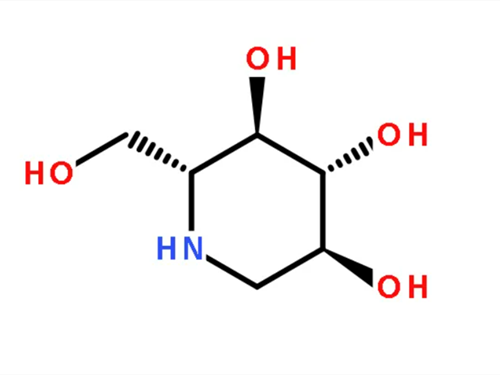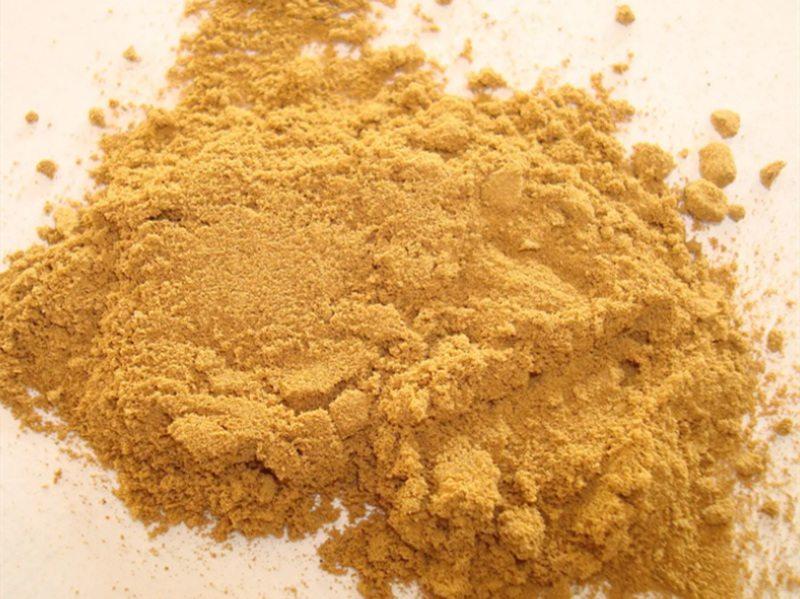Deoxynojirimycin (1-DNJ) is a piperidine-like polyhydroxy alkaloid extracted from mulberry leaves. Its chemical name (2R,3R,4R,5S) -2-hydroxymethyl-piperidine-3,4,5-triol, with molecular formula C6H13NO4 and molecular weight 163.17. DNJ was first isolated and purified from Mulberry root bark by Japanese scholar Yoshiaki et al in 1976. In addition to Mulberry, 1-DNJ and its analogues were also found in the plants of Commelinaceae, hyacinth, and Psammophyllum, but their contents were lower than those of Mulberry. DNJ has a structure similar to α-1, 4-glucose and is a powerful α -glucosidase inhibitor, which has been found to have good hypoglycemic, hypidemic and antioxidant effects.
The Source of DNJ
DNJ was extracted from plants and microorganisms. According to the literatures reported so far, the Mulberry leaf extract has the most abundant content of DNJ, and the DNJ isolated by microorganism mainly comes from Streptomyces and Bacillus. Almost all parts of mulberry were found to contain DNJ, but the content of DNJ varied with species, cultivation area, picking time and picking location. In addition, it was also isolated from plants such as Commelianceae, hyacinth, Radix Platycodontidae, and Pyrrhaceae. Sugiyama Makoto et al. first isolated DNJ producing Streptomyces SEN-158 and GC-148148(Strep Tomyces Lavendulae) from the soil. DNJ can also be produced by synthetic method. The following table shows the content of DNJ in different plants.
| Plant | Family | Part contain DNJ | Content of DNJ |
| Mulberry | Moraceae | Root
Branch Leaf |
0.624
0.0825-0.2382 0.08-0.344 |
| Wild Commelinacommunis | Commelianceae | / | 0.01125 |
| Hyacinthus | Liliaceous/ Hyacinthaceae | Bulbus | 0.0012 |
| Psammophyllum | Hyacinthaceae | / | 0.00086 |
| Jacobinia suberecta | Acanthaceae | leaf | / |
Extraction, separation and purification of DNJ
The extraction methods of DNJ from Mulberry mainly include distilled water extraction, hydrochloric acid extraction, deionized water decocting, ethanol extraction and microwave-assisted extraction. In the purification technology, most of the cation exchange resin method, reverse chromatography purification technology is also a little research. 1-DNJ exists in cells and is soluble in water. Cell structures such as cell wall need to be destroyed before extraction. Therefore, assisted methods such as microwave and ultrasound are conducive to the extraction of 1-DNJ. Specific methods include:
- Mulberry leaves were crushed and put into distilled water for reflux heating. After 2-2.5h, the aqueous solution was filtered and extracted again. The extracted solution was combined twice, filtered, heated and concentrated, and then purified with ionizing exchange resin.
- Decocted with 6 times amount of deionized water 3 times, each time for 3h, 2h and 1.5h respectively. After three times of filtrate concentration, an equal volume of 95% ethanol was added. After standing for 12 hours, precipitation was filtered and ethanol was recovered by decompression to obtain DNJ crude extract with recovery rate of 95.98%.
- DNJ was first extracted with deionized water decocted method, and then purified with 732(H type) ion exchange resin. The average recovery of DNJ was 96.1%.
- Mulberry leaves were extracted with 70% ethanol, concentrated, macroporous adsorption resin, over-cation exchange resin, distilled water, 0.5mol/L ammonia elution, purified by silica gel after concentration, combined with pure components containing DNJ, concentrated and vacuum dried. The DNJ content was 23.2% and the extraction rate was 0.355%.
The effects of different factors on the extraction rate of DNJ were compared. The optimal extraction conditions were as follows: 65% ethanol as an extraction agent, solid-liquid ratio 1:8, ultrasonic enhanced cell crushing 20min(1800W), the extraction rate of 95.8%; Purified by cation exchange resin, the yield of DNJ was 124.54mg/100g, and the purity was more than 92.3%.
Some scholars used microwave-assisted extraction to extract 1-DNJ from Mulberry leaves. Microwave-assisted extraction is the combination of microwave extraction and traditional solvent extraction. Through the dipole, molecular movement is induced in the material or solvent, resulting in the heating of the sample, and the heating makes the plant cells evaporate and lose water. A new extraction technique in which the steam produces expansion, eventually causing the cell to burst and release its active ingredients. The extraction of 1-DNJ was affected by microwave treatment time, power, solid-liquid ratio and extraction times. The optimal extraction process was as follows: the extraction rate of 1-DNJ was 0.024%, the microwave treatment time was 1.5min, the power was 406W, the solid-liquid ratio was 1∶40 and the extraction times was 2. Compared with traditional extraction technology, this method has the advantages of low extraction temperature, less extraction times, no thermal inertia (easy to control), high efficiency, less solvent and low cost.
DNJ Detection Method
1-DNJ belongs to piperidine-type alkaloid, which does not contain chromophore such as benzene ring, double bond and carbonyl group, and has low light absorption in the UV wavelength range, so it cannot be detected by a UV detector. In addition, the structure of piperidine alkaloid contains multiple hydroxyl groups, and the molecular polarity is large, so it is difficult to be qualitative by photometric detection method. The instrument used in ultraviolet spectrophotometry is relatively simple, but it has the disadvantage of low sensitivity due to the interference of chromophore groups and other colored substances.
The commonly used detection methods for DNJ content include pre-column derivatization high performance liquid chromatography, high-performance liquid chromatography, spectrophotometer, high-performance liquid chromatography-differential refractometry, Leipton salt colorimetric method, weather chromatography, etc. The linear range of each detection method is different due to the difference of chromatographic conditions (see table below). Among them, the HPLC-ELDS method is more convenient, fast and sensitive. HPLC-ms /MS is a new quantitative determination method for DNJ in mulberry leaves developed by Nitra et al. Its limit of detection (S/N = 3) is 75pg and the limit of quantitation (S/N = 10) is 100pg, making the detection more sensitive.
Different detection methods and specific parameters of DNJ
| Determination method | Derivative or chromogenic agent | Detector | linearity range/μg/ml |
| High-performance liquid chromatography | Fluorene methoxyl chloride | Fluorescence detector | 0.567-34 |
| High-Performance Liquid Chromatography (HPLC-ELDS) | / | Evaporative light scattering detector | 2.11-21.2 |
| HPLC-DAD | Fluorene methoxycarbonyl chloride | DAD detector | 0.0163-0.3250 |
| Pre-column derivation-reversed-phase high-performance HPLC | Fluorene methoxycarbonyl chloride | Fluorescence detector | 0.5-60 |
| Reversed-phase high-performance liquid chromatography | Methyl 9-fluorenyl chloroformate | Fluorescence detector | 3.6-36 |
| High-performance liquid chromatography-tandem quadrupole mass spectrometry | / | Atmospheric pressure chemical ionization source | 0.482-2.410 |
| Capillary column gas chromatography | Acetyl acetate | With flame ion detector | 0.01-10 |
| Pre-column derivatization high-performance liquid chromatography | 6-aminoquinoline-N-hydroxysuccinic carbamate | Fluorescence detector | 0.5-25 |
| Pre-derivated reversed-phase high-Performance Liquid Chromatography | 9-fluorene methyl chloroformate | UV detector | 2.0-60 |
| Spectrophotometric determination | Iodine-potassium iodide test solution | UV-vis spectrophotometer | 0.25-4 |
| HPLC–MS/MS | / | Mass spectrometer | 0.1-10 |
| High-performance liquid chromatography | / | Differential refractometer detector | 5.0-400.0 |
| Redwood salt colorimetry | / | Ultraviolet spectrophotometer | 0.4-40.4 |
The Benefits of DNJ
Lower blood sugar
DNJ has a structure similar to α-1, 4-glucose and can competitively inhibit the production of sugar in the metabolism of the body, so it has a hypoglycemic effect and can be used to treat diabetes and its complications, obesity and related dysfunction.
The hypoglycemic effect of DNJ was studied in alloxan induced diabetic mice, and the reaction of the mice was observed by oral supplementation of DNJ and polysaccharide. It was found that the levels of blood glucose, glycated hemoglobin, triglyceride, aspartate aminotransferase and alanine aminotransferase decreased significantly, body weight, plasma insulin level and high density lipoprotein increased significantly in diabetic mice fed with DNJ and polysaccharide mixture. The reverse transcription polymerase chain reaction showed that The expression of GCK type, PEPCK and G-6-Pase in the liver and pdX-1,insulin-1 and insulin-2 in the pancreas were positively and negatively regulated by DNJ and polysaccharide mixed feeding area. Regulation and liver glycogen metabolism and gluconeogenesis. Because DNJ does not have the action of hydroxyl free radicals and superoxide free radicals, it cannot repair the damaged islet β cells, so it can only reduce blood glucose to a certain level but cannot return to the original state with the help of polysaccharides.
Inhibiting tumor
DNJ could significantly inhibit the invasion, metastasis and cell adhesion of B16F10 cells, with inhibition rates of 50%, 35% and 60%, respectively. The inhibition activity of MMP-2 and MMP-9 was significantly inhibited at 50μg/mL and reached 20% at 50μg/mL. The inhibition rate of MMP-2 and MMP-9 mRNA expression was 60% and 28%, respectively. There was no significant effect on the expression of TIMP1 mRNA, but the expression of TIMP2 mRNA was increased by 31%. In addition, DNJ increased cell surface α -mannose levels by 49%, decreased oligosaccharide levels by 21%, and methylated levels by 30%. These results suggest that DNJ can be used as an adjuvant agent to inhibit the metastasis of cancer cells.
Inhibiting virus
Papandreou found that low concentrations of DNJ could inhibit THE HIV capsid regulation of the glycoprotein membrane fusion of CXCR4 and thus inhibit HIV damage to the body. In addition, the inhibition of DNJ against Molony mouse leukemia virus (MoLV) showed that DNJ had a significant anti-retrovirus activity with IC50 of 1.2-2.5 μg/ mL, and the inhibition increased with the increase of DNJ dose. Steinmann E et al. found that HCV was rapidly killed after adding long alkyl chain DNJ into the culture medium of HCV infected cells, indicating that DNJ is a potential drug for the treatment of viral hepatitis C.
A large number of studies have shown that DNJ has a variety of active functions, including lowering blood glucose, inhibiting tumor metastasis and antiviral activity, making it a hotspot of current research. Mulberry is one of the species with a relatively high content of 1-DNJ, but it is limited by its extraction and purification production process. The discovery of genes regulating DNJ synthesis in Bacillus 3K85 strain also provides a basis for the large-scale synthesis of DNJ by microorganisms. At present, natural 1-DNJ powder has become a research hotspot.




